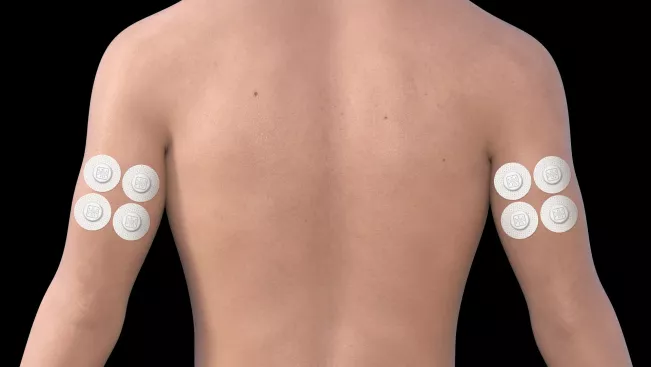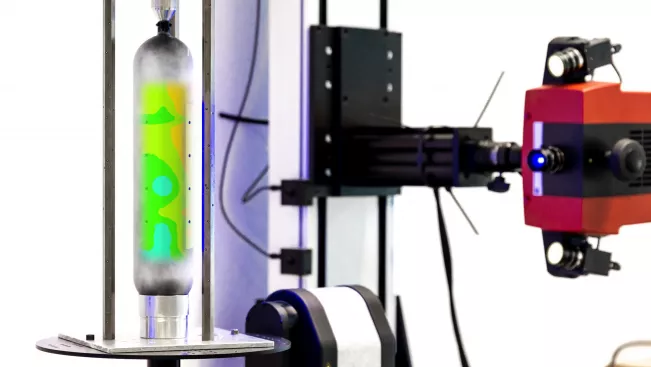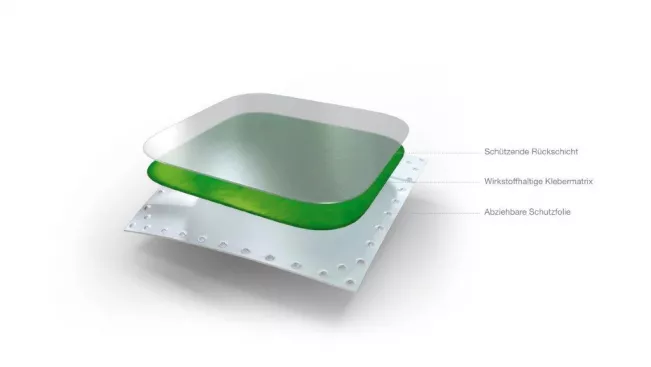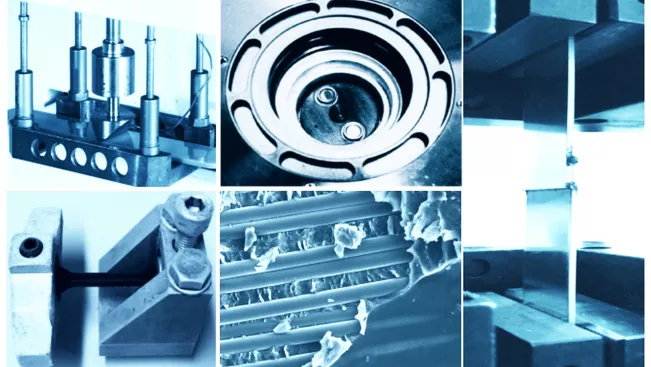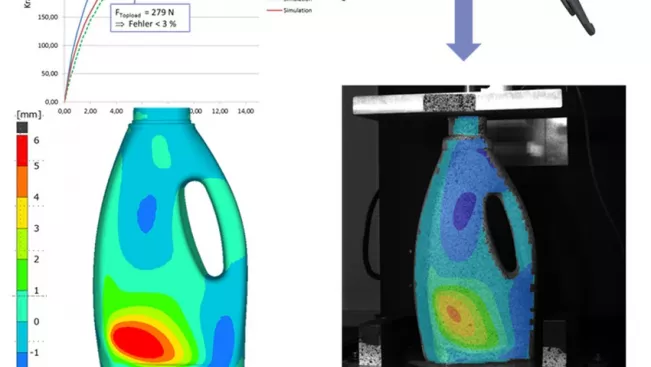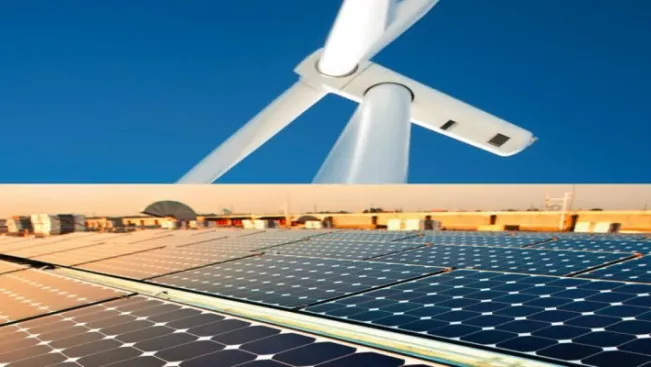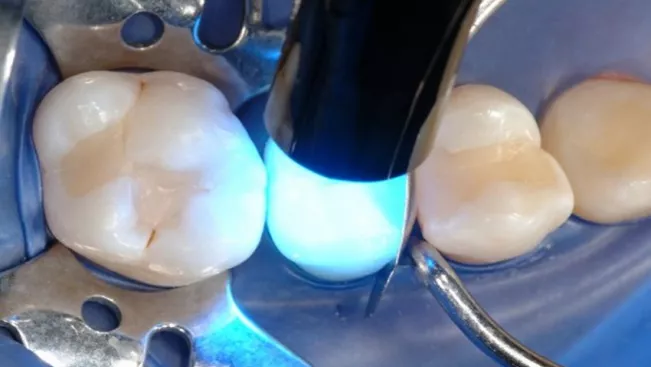Fachbereich Angewandte Naturwissenschaften

Prof. Dr. Bernhard Möginger
Professor für Werkstoff- und Bauteilprüfung - Polymere/Gründungsdirektor – Instituts für Technik, Ressourcenschonung und Energieeffizienz /Seniorprofessor seit 1. September 2022
Gliederung
Fachbereich Angewandte Naturwissenschaften
Standort
Rheinbach
Raum
I 205
Adresse
von-Liebig-Str. 6
53359, Rheinbach
Telefon
+49 2241 865 531Profil
Lehrveranstaltungen – aktuell
- Composites and Hybrid Structures (PF – 3. Semester Master MSSM)
- Rubber Materials (WPF – 2. Semester Master MSSM)
Lehrveranstaltungen – ehemals
Pflichtfächer
- Struktur und Eigenschaften der Materialien – Teil Polymere
- Mikroskopie
- Forensische Mikroskopie
- Makromolekulare Chemie
- Polymere und Verbunde
- Physik der Polymere – Teil: mechanische Eigenschaften (FH AC)
Wahlpflichtfächer:
- Fortgeschrittene Methoden der mechanischen Werkstoffprüfung
- Thermische Analyse
- Rubber Materials
- Faserkunststoffverbunde (FH AC)
Forschungsgebiete
- Härtungskinetik reaktiver Polymersystemen (harzbasierte Dentalmaterialien, Knochenzemente, 3D-Harzdrucksysteme, EP-Harzsysteme für elektronische Anwendungen)
- Charakterisierung des Adhäsions- und Ablöseverhaltens transdermaler Therapiesysteme (Medizinpflaster)
- Modellierung der mechanischen und thermischen Eigenschaften verstärkter und gefüllter Polymerwerkstoffe im Hinblick auf anisotropes Verhalten unter Nutzung des ElementarVolumenConcepts
(spritzgegossene kurzglasfaser- und teilchenverstärkte Thermoplaste) - Langzeit- und Alterungsverhalten von Polymerwerkstoffen
- Struktur-Eigenschafts-Beziehungen von Polymerwerkstoffen
- Ökobilanzaspekte polymere Materialien
Sonderaufgaben an Hochschule und Fachbereich
- Mitglied im Fachbereichsrat (2000 – 2009)
- Mitglied des Prüfungsausschusses (2000 – 2013) davon als
Vorsitzender des Prüfungsausschusses (2000 – 2010) - Mitglied des Senats (2008 - 2019) davon als
Vorsitzender des Senates (2015 – 2019) - Vorsitzender des Auswahlgremiums für den Hochschulrat (2017)
- Vorsitzender der Hochschulwahlversammlung (2017)
- Vorsitzender der Findungskommission Kanzlerin (2018 – 2019)
- Stellvertretender Sprecher der Kompetenzplattform „Polymere Materialien“ (gemeinsam mit FH AC) (2007 – 2016)
- stellvertretender Sprecher der FH Struktur Maßnahme „Nachhaltigkeit in Werkstoff- und Energietechnik“ (NaWETec) (2014 – 2018)
- Gründungsdirektor des Instituts für Technik, Ressourcenschonung und Energieeffizienz (TREE) (2014 – 2020)
Kooperationsfelder
- Prüfmethodiken zur Eigenschafts- und Strukturanalyse polymerer Werkstoffe
- Schadenanalyse von Kunststoffbauteilen
- Beratung bei Auslegung und Werkstoffauswahl
Lebenslauf
1976 – 1985 Studium der Physik an der Universität Ulm
Diplomarbeit im Bereich der Polymerphysik
1986 – 1992 Promotion am Institut für Kunststoffprüfung und Kunststoffkunde der Universität Stuttgart
1992 – 1996 Gruppenleiter des Werkstofflabors bei Busak + Shamban Dichtungssysteme in Stuttgart
1996 – 1999 Leiter der Abteilung "Plastographie und Polymerphysik" am Institut für Kunststoffprüfung und Kunststoffkunde der Universität Stuttgart
seit 9/1999 Professor für Werkstoff- und Bauteilprüfung - Polymere an der Hochschule Bonn-Rhein-Sieg
2002 DAAD Kurzzeitdozentur am Polymer Lab der Chung Gung Universität in Taoyuan, Taiwan
2005 Forschungsaufenthalt (3 Monate) bei Prof. Igor Emri am Center of Experimental Mechanics der Universität Ljubljana, Slowenien
2009 Forschungsaufenthalt (1 month) bei Prof. Lourdes de Vargas am Laboratorío de Reología im Politecnico, Mexico City
2012 Praxisaufenthalt (3 Monate) bei PE International, experts in sustainability, Leinfelden-Echterdingen
Forschungsaufenthalt (3 Monate) bei Prof. Alan Brent am Center for Renewable Sustainable Energy Studies der Universität Stellenbosch, Südafrika
2016 Forschungsaufenthalt (3 Monate) bei Prof. Richard Price an der Zahnklinik der Dalhousie Universität in Halifax, Nova Scotia, Kanada
Forschungsaufenthalt (1 Monat) bei Prof. Jack Ferracane an der Oregon Health and Science University in Portland, Oregon, USA
2018 Forschungsaufenthalt (1 Monat) bei Prof. Richard Price an der Zahnklinik der Dalhousie Universität in Halifax, Nova Scotia, Kanada
Forschungsprojekte
Medizinische Patches sind beispielsweise Transdermale Therapeutische Systeme (TTS), welche speziell dazu gedacht sind Arzneimittel über die Haut mittels Diffusion in den Blutkreislauf einzubringen, oder aber auch Pflaster mit Sensorfunktion wie z.B. Diabetes-Sensoren. Je nach Anwendungsfall sind verschiedene Aspekte hinsichtlich der Eigenschaften medizinsicher Patches zu berücksichtigen, welche teils widersprüchlich sind, jedoch in Einklang gebracht werden müssen. Von besonderem Interesse sind hierbei das Adhäsions- und Delaminationsverhalten der Patches auf hautähnlichen Substraten, welche im Projekt AdTTSWes experimentell und numerisch untersucht werden.
Projektleitung an der H-BRS
Prof. Dr. Christian DresbachKunststoffverpackungen erfüllen in der modernen Gesellschaft für Konsumenten und Industrie wichtige Funktionen und sind im Alltag unverzichtbar: In großen Stückzahlen leicht und kostengünstig herstellbar, vereinfachen sie deutlich Handhabung bei Transport und Lagerung und verlängern die Haltbarkeit von Lebensmitteln bis zum Dreifachen.
Projektleitung an der H-BRS
Prof. Dr. Christian Dresbach Dr. Esther van DorpDurch Berücksichtigung der Patienteneigenschaften Hauttyp, Hauttextur, Transpirationsverhalten usw. im Aufbau der Transdermalen Therapiesysteme TTS (Wirkstoff- Therapiepflaster) könnten die Effektivität der Wirkstoffe erhöht und die Nebenwirkungen durch Kombination von optimierter Dosierung und hautadaptiertem Verhalten reduziert werden.
Projektleitung an der H-BRS
Prof. Dr. Bernhard MögingerDie Herstellung qualitativ hochwertiger Kunststoffprodukte, Verbundwerkstoffe sowie Verklebungen erfordert: eine umfangreiche Materialkenntnis verlässliche Qualitätseingangs- und –ausgangskontrollen hohe Prozesssicherheit verlässliche Lieferanten Bereits in der Konstruktion muss eine sorgfältige Materialauswahl stattgefunden haben. Nicht nur die Materialkosten sondern vor allem die in der Anwendung auftretenden Belastungen und Medieneinflüsse müssen berücksichtigt werden.
Projektleitung an der H-BRS
Prof. Dr. Johannes SteinhausIm Entwicklungsprozess extrusions- blasgeformter Bauteile ist der Einsatz der FEM-Strukturanalyse heute Stand der Technik. Produkteigenschaften wie die Stapelfähigkeit können mit guter Genauigkeit vorhergesagt werden. Jedoch ist es sehr aufwendig, die für eine aussagefähige Simulation notwendigen Materialkennwerte zu ermitteln. Aufgrund der Verstreckung des Materials im Blasformprozess in Verbindung mit hohen Abkühlgeschwindigkeiten werden die Eigenschaften thermoplastischer Werkstoffe durch den Verarbeitungsprozess signifikant beeinflusst.
Projektleitung an der H-BRS
Prof. Dr. Dirk ReithDer weltweite Kunststoffverbrauch wird sich von derzeit ca. 270 Millionen Tonnen bis 2030 auf etwa 600 Millionen verdoppeln und dann einen beträchtlichen Anteil der geförderten Ölmenge verbrauchen. Aus diesem Grund sind beträchtliche Anstrengungen hinsichtlich einerseits der effizienten Nutzung der eingesetzten Rohstoffe und Energie sowie andererseits der Erschließung von nachwachsenden Ressourcen im Sinne des nachhaltigen Wirtschaftens erforderlich. Um diese Ziele zu erreichen, ist interdisziplinäre Forschung und Zusammenarbeit entlang der gesamten Wertschöpfungskette notwendig.
Projektleitung an der H-BRS
Prof. Dr. Johannes GeilenDie Hochschule Bonn-Rhein-Sieg - einfach ausgezeichnet. Studieren Sie bei uns! Es erwartet Sie ein praxisorientiertes Studium auf der Basis aktueller Forschungsergebnisse.
Projektleitung an der H-BRS
Prof. Dr. Johannes GeilenZiel des Forschungsprojektes MatRes ist eine verbesserte Material- und Ressourceneffizienz für blasgeformte Verpackungsartikel unter drei Liter. Erreicht werden soll dies einerseits durch die Weiterentwicklung von theoretischen Ansätzen wie der FEM-Strukturanalyse. Wesentliche Produkteigenschaften können damit schon in der Enwicklungsphase vorhergesagt werden. Andererseits ist es notwendig, die Maschinentechnik weiter zu entwickeln, um die theoretisch errechneten und optimierten Wanddickenverteilung überhaupt fertigen zu können.
Projektleitung an der H-BRS
Prof. Dr. Johannes GeilenZiel dieses Projektes ist die Untersuchung des Härtungsprozesses von lichthärtenden Dental-Füllungskompositen. Dies geschieht zum einen während der Belichtung in Echtzeit mittels Dielektrischer Analyse (DEA). Diese Methode ermöglicht es das Härtungsverhalten von Harzen in dem elektrischen Wechselfeld einer Kammelektrode zu verfolgen. Sie ist weit verbreitet in der Kontrolle von Härtungsprozessen in der Luftfahrt sowie der Automobilindustrie, jedoch findet sie in zahnmedizinischen Einsatzgebieten nur selten Anwendung.
Projektleitung an der H-BRS
Prof. Dr. Bernhard MögingerPublikationen
- Modeling of Creep Behavior of Particulate Composites with Focus on Interfacial Adhesion Effect, International Journal of Molecular Science, 23, 14120 (2022) https://doi.org/10.3390/ijms232214120
- Introduction of an adhesion factor to cube in cube models and its effect on calculated moduli of particulate composites, Scientific Reports, 12, Article number: 16225 (2022)
- Process-Induced Morphology of Poly(Butylene Adipate Terephthalate)/Poly(Lactic Acid) Blown Extrusion Films Modified with Chain-Extending Cross-Linkers, Polymers, 14, 1939 (2022) https://doi.org/10.3390/polym14101939
- RheoTack—An approach to investigate retraction rate dependent detaching behavior of pressure sensitive adhesives, Journal of Rheology 66, 505 (2022) https://doi.org/10.1122/8.0000405
- The Effects of Chain-Extending Cross-Linkers on the Mechanical and Thermal Properties of Poly(butylene adipate terephthalate)/Poly(lactic acid) Blown Films, Polymers 13, 3092 (2021) https://doi.org/10.3390/polym13183092
- Nonlinear oscillatory shear tests of pressure-sensitive adhesives (PSAs) designed for transdermal therapeutic systems (TTS), Rheologica Acta, 60, 553–570 (2021)
- https://doi.org/10.1007/s00397-021-01280-6
- Thermal expansion of semi-crystalline polymers: Anisotropic thermal strain and crystallite orientation, Polymer, 191, (2020) https://doi.org/10.1016/j.polymer.2020.122249
- Local process-dependent structural and mechanical properties of extrusion blow molded high-density polyethylene hollow parts, Polymer Testing, 82, 106314, (2020) https://doi.org/10.1016/j.polymertesting.2019.106314
- Process-dependent structural and deformation properties of extrusion blow molding parts, Polymer Testing, 77, 105903 (2019) https://doi.org/10.1016/j.polymertesting.2019.105903
- Development of an Advanced Dynamic Microindentation System to Determine Local Viscoelastic Properties of Polymers, Polymers, 11 (5), 833 (2019) https://doi.org/10.3390/polym11050833
- On merging DMA and micro-indentation to determine local mechanical properties, Polymer Testing, 68, 359-364 (2018) https://doi.org/10.1016/j.polymertesting.2018.04.020
- Correlating mechanical rubber properties with moving die rheometer vulcanization curves under consideration of the material composition, Proceedings of Nordic Rheology Conference (2019)
- Viscoelastic modelling of stress-strain-behaviour of two-phase model materials (ABS and PCL-TPS Blends), Proceedings of Nordic Rheology Conference (2019) https://doi.org/10.13140/RG.2.2.26571.75049
- Das Härtungsverhalten verschiedener Dentalkomposite, ZKM (2017)
- Curing behavior and reaction kinetics of binder resins for 3D-printing investigated by dielectric analysis (DEA), AIP Conference Proceedings 1736, 020074 (2016) http://dx.doi.org/10.1063/1.4949649
- Qualitative Beam Profiling of Light Curing Units for Resin Based Composites, European Journal of Prosthodontics and Restorative Dentistry, 24 (4), 197-202 (2016) https://doi.org/10.1922/EJPRD_1513Haenel06
- Photopolymerization of highly filled dimethacrylate-based composites using Type I or Type II photoinitiators and varying co-monomer ratios, Dental Materials, 32 (2), 136-148 (2016) https://doi.org/10.1016/j.dental.2015.11.032
- Correlation of dynamic viscosity and dielectric ion viscosity of dental resins – Effects of composition, temperature and filler content, Dental Materials 32 (7), 899-907 (2016) https://doi.org/10.1016/j.dental.2016.03.015
- Highly Time Resolved Measurements of the Degree of Conversion of a Resin Based Composite At Irradiance Levels Up to 7.5 W/cm2, Dental Materials, 31 (5), 583-593 (2015) https://doi.org/10.1016/j.dental.2015.02.010
- Modeling curing kinetics and degree of conversion of visible light curing resin based composites (VLC RBC) using a time dependent reaction constant, Conference of European Dental Materials in Nürnberg (2015)
- Effect of composition on the curing behaviour of visible light-curing resins measured with dielectric analysis, Conference of European Dental Materials in Nürnberg (2015)
- Characterization of the Auto-Curing Behavior of Rapid Prototyping Materials for Three-Dimensional Printing Using Dielectric Analysis, Polymer Engineering and Science, 55 (7), 1485-1493 (2015) https://doi.org/10.1002/pen.24100
- Effect of the Irradiance Distribution from Light Curing Units on the Local Mechanical Behavior of Dental Resins, Dental Materials 31 (2), 93-104 (2015) https://doi.org/10.1016/j.dental.2014.11.003
- Dielectric analysis of depth dependent curing behavior of dental resin composites, Dental Materials 30 (6), 679-687 (2014) https://doi.org/10.1016/j.dental.2014.03.002
- Curing kinetics of visible light curing dental resincomposites investigated by dielectric analysis(DEA), Dental Materials 30 (3), 372-380 (2014) https://doi.org/10.1016/j.dental.2013.12.013
- Time-Resolved Study of the Photo-Curing Process of Dental Resins with the NMR MOUSE, Applied Magnetic Resonance, 44, 1027–1039 (2013) https://doi.org/10.1007/s00723-013-0458-6
- Initiation and Curing of VLC Resin Composites – Estimation of the Minimal Irradiation Time, Conference of European Dental Materials in Birmingham (2013)
- Lichthärtende Dentalkomposite – Einflüsse auf die Aushärtung, ZWR Das Deutsche Zahnärzteblatt, 122 (3) (2013)
- LCA’s theory and practice: Like ebony and ivory living in perfect harmony? International Journal of Life Cycle Assessment 18 :5-13 (2013) DOI: https://doi.org/10.1007/s11367-012-0476-x
- Aktuelle und zukünftige Herausforderungen der Werkstoffprüfung und Schadenanalyse in der Kunststofftechnik, Dialog Materialwissenschaft und Werkstofftechnik, DGM 52-56 (2012)
- Real-time observation of the degree of conversion of dental resins having a wide range of
- CQ-concentrations using ATR-FTIR, AODES Conference in Leuven (2012)
- Post-Curing of Photo-Polymeric Dental Composites- Effects on Mechanical and Dielectric Performance, European Polymer Congress in Granada (2011) https://doi.org/10.13140/2.1.1135.2320
- Evaluation of a dielectric real-time curing monitoring method by Investigating the curing behaviour of light-curing dental filling composites, Proceedings of SEMDOK – 16th International PhD. Students’ seminar, Žilina - Terchová, Slovakia (2011)
- Evaluation of dielectric curing monitoring investigating light-curing dental filling composites, Materials Engineering, Vol. 18, 28-33, (2011)
- High Rate Tensile Tests – Measuring Equipment and Evaluation, Polymer Testing, 29, 265-272 (2010)
- Dielectric Analysis of Short-Term and Long-Term Curing of Novel Photo-Curing Dental Filling Materials, Modern Trends in Polymer Science – EPF’09, Wiley, 622-625, (2009)
- Dielectric real-time analysis of the photo-curing and post curing behaviour of dental composite fillings, Transcom 2009, Proceedings, Sec 5, 197-200, (2009)
- Determination of Young’s Modulus and Tensile Strength of Viscoelastic Polymers at High Strain Rates, 22nd Canadian Conf. of Appl. Mechanics, 220-221 (2009)
- Quasi Static Indentation Measurements: A Tool for Micromechanical Investigations of Interfaces in Polymer Materials in Forschungsspitzen und Spitzenforschung, Physica-Verlag Heidelberg, 315.327, (2008), ISBN 978-3-7908-2126-0
- Mechanical Performance of Thermoplastic Polymers at High Strain Rates, Proceedings of 6th Int. Conf. on mechanics of time dependent materials (2008)
- High speed tensile testing of thermoplastic polymers (POM), Proceedings of 12th International Workshop on Advances in Experimental Mechanics (2007))
- A Tool for Micro-mechanical Investigations of Interfaces in Polymer Materials, International Journal of Polymer Analysis and Characterization (IJPAC) 11, 1-14 (2006)
- Interface Adhesion and Longterm Creep of Short Glass Fiber and Glass Sphere Reinforced Polymers, Proceedings of 5th int. conf. on mechanics of time dependent materials, Karuizawa (2005)
- Dynamic Indentation (DIM) to Determine Micro-Mechanical Properties, Proceedings of 10th International Workshop on Advances in Experimental Mechanics, Portoroz (2005)
- Methoden der Echtzeitanalyse der Polymerisationskinetik bei lichthärtenden Kompositen, 18. Jahrestagung der DGZ, Wuppertal (2004)
- Micromechanical Investigation of Polymer Interfaces, Proceedings of 16th International Slovak Rubber Conference, Puchov (2004)
- The Creep Behaviour of Glass Sphere Filled Polybutylene Terephthalate (PBT), Proceedings of 4th int. conf. on mechanics of time dependent materials, Lake Placid (2003)
- Quasi Static Indentation Mapping (QSIM) - a Method to Determine and Map Mechanical Properties on a Micro-Scale, Proceedings of 8th International Workshop on Advances in Experimental Mechanics, Portoroz (2003)
- Temperature and strain rate dependent simulation of high speed tensile tests before yielding, Proceedings of Meeting of the Polymer Processing Society (PPS), Melbourne (2003)
- Modeling mechanical properties of short fiber reinforced composites using the EVC – a comparision to experiment and other models, Proceedings of Asia/Australia Regional Meeting of the Polymer Processing Society (PPS), Taipei (2002)
- Modeling nonlinear viscoelastic creep of polymers, Proceedings of 7th International Workshop on Advances in Experimental Mechanics, Portoroz (2002)
- A 3-D modelling of the flow behaviour of short fiber feinforced polymer melts using the software package ”FLUX-EXPERT”, Proceedings of Europe/Africa Regional Meeting of the Polymer Processing Society (PPS), Antalya (2001)
- Investigation of the temperature dependent curing behaviour of epoxy resins to optimize annealing cycles of resin tools, Proceedings of Europe/Africa Regional Meeting of the Polymer Processing Society (PPS), Antalya (2001)
- ABS model materials – a system to investigate the macro-stiffness and its relationship to the micro-stiffness properties of the phases, Proceedings of Europe/Africa Regional Meeting of the Polymer Processing Society (PPS), Antalya (2001)
- Determination of mechanical stiffness of microphases in ABS model materials using AFM indentation, Proceedings of 6th International Workshop on Advances in Experimental Mechanics, Portoroz (2001)
- Modelling short fiber reinforced materials using the Elementary Volume Concept, Proceedings of 6th International Workshop on Advances in Experimental Mechanics, Portoroz (2001)
- Simulation der mechanischen Eigenschaften von partiell ausgerichteten Verbundwerkstoffen mit Hilfe des “Elementar-Volumen-Concepts”, Stuttgarter Kunststoff Kolloquium Tagungsband Beitrag P4.3 (2001)
- Herstellung orientierter Strukturen im Gegentaktspritzgiessverfahren, Stuttgarter Kunststoff Kolloquium Tagungsband Beitrag P3.6 (2001)
- Size effects on the creep behaviour of short fiber reinforced and unreinforced polypropylene and its modelling in the elementary volume concept (EVC), Proc. 3rd int. conf. on mechanics of time dependent materials, Erlangen (2000)
- Determination of mechanical phase properties of ABS model materials, , Proceedings of Europe/Africa Regional Meeting of the Polymer Processing Society (PPS), Zlin, CZ, (2000)
- Investigations on Deformation Behaviour and Morphology of i-PP with Oriented Lamellae Structure, Proceedings of Europe/Africa Regional Meeting of the Polymer Processing Society (PPS), Zlin, CZ, (2000)
- Modeling Mechanical Properties of Short Fibre Reinforced Composites Using the Elementary Volume Concept, Proceedings of Europe/Africa Regional Meeting of the Polymer Processing Society (PPS), Zlin, CZ, (2000)
- Mechanical Properties of Isotactic Polypropylene with Oriented and Cross-hatched Lamellae Structure, Hanser Publishers, Munich, Intern. Polymer Processing XV (2000) 2, S. 202 - 207
- Brittle Fracture Phenomenon in ABS-Thermoplastics, 3rd ESAFORM Conference on Material Forming, H.-G. Fritz (Editor), Stuttgart (2000), XI 18 – XI 21
- Study on epoxy novolac and carbon fiber reinforced epoxy novolac composites for use as implant materials – Part 2: Physico-chemical properties 265-285, Journal of Polymer Engineering 19 (1999) 4
- Study on epoxy novolac and carbon fiber reinforced epoxy novolac composites for use as implant materials –Part 1: Mechanical and viscoelastic properties 243-263 Journal of Polymer Engineering 19 (1999) 4
- Textile Structure Reinforced Composite Material using RTM with e-Caprolactam, Proceedings 6th Int. Conference on Composites Engineering ICCE/6, Orlando (1999)
- Mechanical properties of unreinforced isotactic polypropylene (i-PP) dependent on lamellae orientation, Proceedings Nordic Polymer Days, Kopenhagen (1999)
- Effects on the creep behaviour of short fiber reinforced polybutylene terephthalate (PBT) processed by conventional injection moulding and push pull processing, Proceedings 15th Annual Meeting of the PPS in s'Hertogenbosch, (1999)
- Solidifiaction in Push-Pull Processing - simulation and comparison to morphology, Proceedings 15th Annual Meeting of the PPS in s'Hertogenbosch, (1999)
- Berechnung mechanischer Kenngrößen von Kurzfaserverbunden mit dem Elementar-Volumen-Konzept, KGK Kautschuk Gummi Kunststoffe 52. Jahrgang Nr. 3/99 (1999)
- Investigating the mechanical behaviour of ABS model materials using the elementary volume concept (EVC), Tagungsband der European Conference on Macromolecular Physics in Merseburg, 339-340 (1998)
- Modification of Polypropylene for high dielectric loss using carbon black, Tagungsband der European Conference on Macromolecular Physics in Merseburg, 337-338 (1998)
- The influence of processing conditions on mechanical properties of unreinforced and discontinuous glass fiber reinforced thermoplastics, Proceedings of the 5th European Rheology Conference in Portoroz, 396-397 (1998)
- Creep behaviour of short glass fibre reinforced and virgin polybutylene terephthalate (PBT) – a comparison of experimental creep data to modelled data using the elementary volume concept (EVC), 5th European Rheology Conference (ERC), Portoroz, Slowenien (1998)
- Modelling YOUNG’s modulus of injection moulded short fiber reinforced composites using the elementary volume concept, Tagungsband des PPS North American Meeting, 158-160 (1998)
- Composites materials using RTM with e-caprolactam, Proceedings of the ECCM 8, Naples (1998)
- Push-Pull-Processing of Unreinforced and Short Fibre Reinforced Thermoplastics, ECCM 8, Naples (1998)
- Effects of morphology on the time dependent creep compliance of ABS model materials having defined size distribution of the butadiene particles, 2nd International Conference on Mechanics of Time Dependent Materials, Pasadena, California, USA (1998)
- Creep of polymers – a nonlinear viscoelastic extension of the time dependent creep compliance and its comparison to experimental results, 2nd International Conference on Mechanics of Time Dependent Materials, Pasadena, California, USA (1998)
- ABS-Sprödbruch – Untersuchungen der Morphologie-Versagens-Beziehung, Tagungsband des 6. Problemseminar, Merseburg (1997)
- Modelling Mechanical Properties of Immiscible Polymer Blends of Thermoplastic Starch and Polycaprolactone using the Elementary Volume Concept, Tagungs-band der European Conference on Macromolecular Physics 1997 in Lausanne (1997)
- Modellierung von Faserverbundkunststoffen: Vergleich zwischen Elementar-Volumen-Konzept (EVC) und Laminat-Theorie, Stuttgarter Kunststoffkolloquium 1997, Tagungsband Beitrag 6.3 (1997)
- Das Elementar-Volumen-Konzept - Ein Modell zur Berechnung der E-Moduln von Kurzfaserverbunden, Stuttgarter Kunststoffkolloquium 1997, Tagungsband Beitrag 6.2 (1997)
- Description of Nonlinear Viscoelastic Creep - A Challenge to Material Science, TMS-proceedings "Creep and relaxation in parts and minature structures" of ASM/TMS meeting in Cincinnati (1996)
- The elementary volume concept - a model to calculate YOUNG's modulus of injection moulded short fiber reinforced composites, European Meeting 1995 of PPS, PPS-Tagungsband, Beitrag 5.25 (1995)
- Viskoelastische Spannungs-Dehnungs-Beziehungen thermoplastischer Polymere – Herleitung und experimentelle Überprüfung, Kautschuk, Gummi, Kunststoffe 4, 256-261 (1994)
- The determination of a general time creep compliance relation of linear viscoelastic materials under constant load and its extension to nonlinear viscoelastic behavior for the BURGER model, Rheologica Acta 32, 370-379 (1993)
- Deformation induced changes of the spherulitic and lamellar structure of polybutylene terephthalate (PBT), Tagungsband des PGS meeting (1991
- Influence of processing on mechanical properties and morphology of PBT, Kunststoffe German Plastics 81 3 (1991)
- Morphological investigations of injection moulded fibre-reinforced thermoplastic polymers. Composites, Vol. 22, 6, 432-436 (1991)
- Determination of the weighting function g(bi, r, vf) for fibre orientation analysis of short fibre-reinforced composites. Composites, Vol. 22, 5, 394-399 (1991)
- Morphological studies of deformed polybutylene terephthalate (PBT), Colloid & Polymer Sci., 269, 535-542 (1991)
- Morphologische Untersuchungen an spritzgegossenen faserverstärkten Thermoplasten. Stuttgarter Kunststoffkolloquium 1991, Tagungsband Beitrag P16 (1991)
- Bestimmung von Spannungs-Dehnungs-Beziehungen thermoplastischer Polymere mit einem linear viskoelastischen Ansatz, Stuttgarter Kunststoffkolloquium 1991, Tagungsband Beitrag 5.2 (1991)
- Thermal properties of strained thermoplastic polymers, Polymer International 26, 121-128 (1991)
- Kontrastierung von teilkristallinen Thermoplasten mit RuO4, BEDO-Band 22 (1989)
- Der Einfluß der Kristallisationsbedingungen auf die Lamellenfeinstruktur von Polybutylenterephthalat. BEDO-Band 22 (1989)
- Einfluß der Verarbeitung auf die mechanischen Eigenschaften und die Morphologie von Polybutylenterephthalat (PBT), Stuttgarter Kunststoffkolloquium 1989, Tagungsband Beitrag 4.1 (1989)
Vorträge
- Diffusion of water solutions in Pressure Sensitive Adhesives (PSA), AG-Seminar, Kröv (2022)
- Thermal lag in polymeric samples during measurements of viscoelastic properties with a DMA (for E. Ramakers-van Dorp), TOP conf., Ischia (2021)
- Development of an advanced micro-indentation method to determine local viscoelastic properties of polymers, Nordic Rheology conf., Göteborg (2019)
- Viscoelastic modelling of stress strain behavior of two phase model ABS and PCL-TPS blends, Nordic Rheology conf., Göteborg (2019)
- Particle sedimentation in a dental resin investigated by dielectric analysis (DEA) using IDEX-sensors, AERC 2019, Portoroz (2019)
- Improved tack characterization of transdermal therapeutic systems (TTS), Poster, AERC 2019, Portoroz (2019)
- Härtungsverhalten und Reaktionskinetik von Harzsystemen, Lohmann, Neuwied (2018)
- Effects of Glass Particle Content on Time Dependent Ion Viscosity Measured by DEA. TBU in Zlin on occasion of Prof. Saha’s 70th birthday, (2018)
- Dielectic analysis of curing behavior and reaction kinetics of acrylate based resin systems, Netzsch DEA user meeting, Augsburg (2017)
- Creep behaviour of short fiber reinforced composites: Effects of fiber orientation and fiber matrix adhesion, ECCM, München (2016)
- Primary-curing and post-curing kinetics of dental resin composites, Dentistry of Oregan Health and Science University, Portland (2016)
- Curing Behavior and Reaction Kinetics of Binder Resins for 3D-Printing Investigated by Dielectric Analysis (DEA), TOP conf., Ischia (2016)
- Gummi-Recycling von LKW-Reifen aus werkstoffwissenschaftlicher Sicht, PolyKing Event, FH Würzburg (2016)
- Härtungskinetik und dielektrische Analyse von Reaktivharzen am Beispiel lichthärtender Dentalkomposite, STEPS-Seminar, TH Köln (2016)
- Polymer Based Light Curing Dental Materials, International Week Tomas Bata University, Zlin, (2016)
- Modeling curing kinetics and degree of conversion of visible light curing resin based composites (VLC RBC) using a time dependent reaction constant, Light Sources in Dentistry III, Dalhousie University, Halifax (2015)
- Modeling curing kinetics and degree of conversion of visible light curing resin based composites (VLC RBC) using a time dependent reaction constant, European Dental Materials conf., Nürnberg (2015)
- Effects of Temperature on Primary Curing Kinetics of Light Curing Dental Composites Investigated by DEA, CED-IADR conf., Antalya (2015)
- Mechanik disperser Polymerwerkstoffe, Fa. Schulman, Kerpen (2014)
- Paths of Rubber Recycling of Truck Tires from a Materials Science Perspective, Industrial Engineering seminar, Stellenbosch University, Stellenbosch (2014)
- Effects of Light Intensity on Curing Behavior of CQ initiated resin composites, Light Sources in Dentistry II, Dalhousie University, Halifax (2014)
- Highly filled hybrid nano resin composites and their light curing behaviour investigated by dielectric analysis (DEA), 12th Annual UNESCO/IUPAC conf, Stellenbosch (2013)
- Dielektrische Analyse (DEA) von Härtungsvorgängen, BMW, Landshut (2013)
- Materialwissenschaften – Treiber von Fortschritt und Wandel, Studieninformationstag der H-BRS (2013)
- Simultaneous long-term DMA-DEA of highly filled visible light curing (VLC) nano-hybrid composites, 18th IWAEM, Portoroz (2013)
- Initiation and Curing of VLC Resin Composites – Estimation of the Minimal Irradiation Time, European Dental Materials conf., Birmingham (2013)
- Strukturbildung aus der Polymerschmelze und deren thermomechanische Modellierung, RedPro-Seminar and der H-BRS (2013)
- Real-time Observation of the Degree of Conversion of Dental Resins Having a Wide Range of CQ-Concentrations using ATR-FTIR, AODES meeting with GC Europe Campus, Poster, Leuven (2012)
- Curing Kinetics of Reactive Photo-Polymeric Dental Materials, Tomas-Bata-University, Zlin (2012)
- FEA-Analysis of Local Stresses in High Impact ABS Model Materials and their Relationship to the Micro-Properties of Matrix and Disperse Phase, CanCAM 2011, Vancouver (2011)
- Dielectric Monitoring of Composite Curing Kinetics in Different Illumination Depths, IADR 2011, Poster, Budapest (2011)
- Hardness Mapping of Light-Cured Composites to Identify Inhomogeneous Curing, IADR 2011, Poster, Budapest (2011)
- Depth Dependent Curing Behaviour of Dental Composites using DEA, IADR 2011, Budapest (2011)
- Polymer Based Light Curing Dental Materials, Tomas Bata University, Zlin (2011)
- Das Relaxationsverhalten von Kunststoffen, Montan-Universität Leoben, Leoben (2010)
- Das Retardationsverhalten von kurzfaserverstärkten Kunststoffen und dessen Modellierung, Montan-Universität Leoben, Leoben (2010
- Dielectric Analysis (DEA) – a Method to Measure the Curing Behaviour of Thermosets, Workshop on Advanced Polymer Systems, Tomas Bata Universität, Zlin (2010)
- Alterung und Lebensdauervorhersage bei Kunststoffen – eine Einführung, Tagung der Kompetenzplattformen LCA und Polymere Materialien, Münster (2010)
- Determination of Young’s Modulus and Tensile Strength of Viscoelastic Polymers at High Strain Rates, 22nd Canadian Conf. of Appl. Mechanics (2009)
- Real time analysis of the curing behaviour of photo-curing dental polymers, Seminar of Dentistry of Dalhousie University, Halifax (2009)
- Physikalische Grundlagen der Thermischen Analyse und Problemlösungsstrategien mit thermoanalytischen Messtechniken, Netzsch-Seminar auf Achema, Frankfurt (2009)
- Viscoelastic Behaviour of Polymers – Some Research Activities, Seminar des Laboratorio de Reologia, Politecnico, Mexiko-Stadt (2009)
- Härtungsverhalten von duromeren Systemen am Beispiel von Dentalmassen, Hauskolloquium des FB 05, Rheinbach (2008)
- Mechanical Performance of Thermoplastic Polymers at High Strain Rates, Proceedings of 6th Int. Conf. on mechanics of time dependent materials (2008)
- Viscoelasticity, Durability and Life Time Estimation of Thermoplastic Polymers, Summer School of Materials – Fatigue, Velka Raca (2008)
- Mechanische Eigenschaften von faserverstärkten Kunststoffen und deren Modellierung, Kolloquium der Kompetenzplattform Polymere Materialien, Aachen (2007)
- Einsatz der TA-Methoden DSC und TGA bei Polymeren, K-Messe, Düsseldorf (2007)
- Kleinwinkellichtstreuung an sphärolithischen Strukturen, LKT, Erlangen (2006)
- Investigation of the Curing Behaviour of Photo-curing Dental Materials
- using DSC and DEA, 34th NATAS Conf., Bowling Green (2006)
- Interface Adhesion and Longterm Creep of Short Glass Fiber and Glass Sphere Reinforced Polymers, Proceedings of 5th int. conf. on mechanics of time dependent materials, Karuizawa (2005)
- Dynamic Indentation (DIM) to Determine Micro-Mechanical Properties, Proceedings of 10th International Workshop on Advances in Experimental Mechanics, Portoroz (2005)
- Einsatz der Thermischen Analyse bei Polymerwerkstoffen, NETZSCH-Fachseminar, Köln (2004)
- Physikalische Grundlagen der Thermoanalyse und Problemlösungsstrategien, NETZSCH-Fachseminar, Köln (2004)
- Micromechanical Investigation of Polymer Interfaces, Proceedings of 16th International Slovak Rubber Conference, Puchov (2004)
- Thermoanalytische Untersuchungen zum Haertungsverhaltens photopolymerer Dentalmassen, NETZSCH Seminar auf der Analytica, München (2004)
- Untersuchungen zur Kinetik des Aushärt- und Nachhärtverhaltens von Kompositen, AfG 35, Mainz (2004)
- The Creep Behaviour of Glass Sphere Filled Polybutylene Terephthalate (PBT), 4th int. conf. On mechanics of time dependent materials, Lake Placid (2003)
- Quasi Static Indentation Mapping (QSIM) - a Method to Determine and Map Mechanical Properties on a Micro-Scale, 8th International Workshop on Advances in Experimental Mechanics, Portoroz (2003)
- Modeling mechanical properties of short fiber reinforced composites using the EVC – a comparision to experiment and other models, Proceedings of Asia/Australia Regional Meeting of the Polymer Processing Society (PPS), Taipei (2002)
- Modelling nonlinear viscoelastic creep of polymers, Proceedings of 7th International Workshop on Advances in Experimental Mechanics, Portoroz (2002)
- ABS model materials – a system to investigate the macro-stiffness and its relationship to the micro-stiffness properties of the phases, Proceedings of Europe/Africa Regional Meeting of the Polymer Processing Society (PPS), Antalya (2001)
- Size effects on the creep behaviour of short fiber reinforced and unreinforced polypropylene and its modelling in the elementary volume concept (EVC), Proc. 3rd int. conf. On mechanics of time dependent materials, Erlangen (2000)
- Modeling Mechanical Properties of Short Fibre Reinforced Composites Using the Elementary Volume Concept, Europe/Africa Regional Meeting of the Polymer Processing Society (PPS), Zlin, CZ, (2000)
- Effects on the creep behaviour of short fiber reinforced polybutylene terephthalate (PBT) processed by conventional injection moulding and push pull processing, 15th Annual Meeting of the PPS in s'Hertogenbosch, (1999)
- Kunststoffe im Fahrzeugbau - Werkstoffauswahl und Werkstoffprüfung anhand von Praxisbeispielen, Fachhochschule Dortmund (1999)
- Werkstoffkombinationen und Prüfungen von Bauteilen in Hybridbauweise anhand von Praxisbeispielen, Fachhochschule Rhein-Sieg in Rheinbach (1998)
- Creep behaviour of short glass fiber reinforced and virgin polybutylene terephthalate (PBT) - a comparison of experimental data to modeled data using the elementary volume concept (EVC)
- 5th European Rheology Conference in Portoroz, (1998)
- Modelling YOUNG’s modulus of injection moulded short fiber reinforced composites using the elementary volume concept, PPS North American Meeting in Toronto, (1998)
- Untersuchung des Stofftransport- und Permeationsverhaltens von elastomeren Werkstoffen und Bauteilen. Frühjahrstagung der Gruppe Süd/Südwest der Deutschen Kautschukgesellschaft, Würzburg (1998)
- Vorstellung des Instituts für Kunststoffprüfung (IKP) als akkreditiertes Prüfinstitut. Frühjahrstagung der Gruppe Süd/Südwest der Deutschen Kautschukgesellschaft, Würzburg (1998)
- Simulation methods to determine mechanical properties of short fiber reinforced polymers, Universität Brno, Faculty of Technology in Zlín (1998)
- Das Ausscheidungsverhalten von Duplexstählen des Typs 1.4517, Fachhochschule Ingolstadt (1998)
- Das elastische Verhalten von Polymerwerkstoffen, Fachhochschule Ingolstadt (1998)
- Effects of Morphology on the Time Dependent Creep Compliance of ABS Model Materials Having Defined Size Distributions of the Butadiene Particles. 2nd International Conference on Mechanics of Time Dependent Materials (1998), Pasadena
- Creep of Polymers - a Nonlinear Viscoelastic Extension of the Time Dependent Creep Compliance and its Comparison to Experimental Results. 2nd International Conference on Mechanics of Time Dependent Materials (1998), Pasadena
- ABS-Sprödbruch - Untersuchungen der Morphologie-Versagens-Beziehung, 6. Problemseminar 1997, Merseburg
- Modelling Mechanical Properties of Immiscible Polymer Blends of Thermoplastic Starch and Polycaprolactone using the Elementary Volume Concept, European Conference on Macromolecular Physics 1997, Lausanne
- Das Elementar-Volumen-Konzept - Ein Modell zur Berechnung der E-Moduln von Kurzfaserverbunden, Stuttgarter Kunststoffkolloquium 1997
- Description of Nonlinear Viscoelastic Creep - A Challenge to Material Science, ASM/TMS meeting in Cincinnati, 1996
- The elementary volume concept - a model to calculate YOUNG's modulus of injection moulded short fiber reinforced composites, PPS European Meeting, 1995
- Temperaturkalibrierung von DSC-Messungen bei hohen Heizraten, 10. Kalorimetrietagung, Ulm 1993
- Deformation induced changes of the spherulitic and lamellar structure of polybutylene terephthalate (PBT). PGS meeting, Lausanne 1991
- Morphological studies of fibre reinforced thermoplastic polymers,PPS European Regional Meeting, Palermo 1991
- Determination of the weighting function g(bi, r, vf) for fibre orientation analysis of short fibre-reinforced composites, PPS European Regional Meeting, Palermo 1991
- Morphologische Untersuchungen an spritzgegossenen faserverstärkten Thermoplasten. Stuttgarter Kunststoffkolloquium 1991
- Bestimmung von Spannungs-Dehnungs-Beziehungen thermoplastischer Polymere mit einem linear viskoelastischen Ansatz, Stuttgarter Kunststoffkolloquium 1991
- Morphological investigations of fibre-reinforced thermoplastic polymers, Makromolekulares Symposium, Hamburg 1990
- Viskoelastische Beschreibung des Deformationsverhaltens thermoplastischer Polymerer. MPI für Polymerforschung, Mainz, Seminarvortrag 1990
- Effects of processing on morphology and mechanical properties of polybutylene terephthalate (PBT). 6th PPS-Meeting, Nizza 1990
- Der Einfluß der Kristallisationsbedingungen auf die Lamellenfeinstruktur von Polybutylenterephthalat, Dreiländertagung Elektronenmikroskopie Salzburg 1989
- Einfluß der Verarbeitung auf die mechanischen Eigenschaften und die Morphologie von Polybutylenterephthalat (PBT), Stuttgarter Kunststoffkolloquium 1989
- Der Einfluß der thermischen Vorgeschichte und des Drucks auf die spezifische Wärme und die Morphologie von Polybutylenterephthalat (PBT), Polymerphysiktagung, Hamburg 1988
